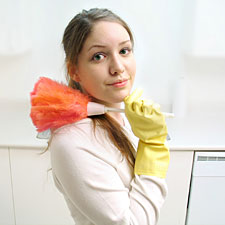
Back to school, back to cooler nights, back to a sneeze-free life? Think again. Ragweed, late summers big offender, lingers well into fall. Plus, your house may be harboring a gang of other allergensdust mites lurking in bedding and carpet, mold thriving on late-season humidity, beloved pets full of dander, not to mention cockroaches and mice ready to come in from the soon-to-be cold. Sounds like its a good time to fortify your germ defenses with these fall-cleaning tips from our allergy experts.
Whole home: Ragweed, pollen, and other airborne uglies
Autumns arrival means sneezing, runny noses, and itchy eyes for up to 20 percent of Americans, thanks to ragweed. Meanwhile, mold and dust mites may already be triggering allergic reactions.
Action plan:
Crank up the AC. It filters incoming air and dehumidifies your house, a hedge against mold and dust mites. Effective air conditioners should keep the humidity level around 30 to 40 percent. To monitor the level of moisture in your air, try a humidity gauge (available at home-improvement stores). If you get a reading above 50 percent with the AC on, your unit may not be powerful enough.
Filter it. Change the filter for your heating-and-AC system monthly to combat clogs that keep it from doing its allergy-fighting job.
Clean the air. Put a free-standing air purifier (www.natlallergy.com has a good selection) in rooms where you spend a lot of time; it may reduce allergic reactions if it has true HEPA (high-efficency particulate air filter) technology, the gold standard when it comes to removing tiny airborne particles. Make sure the packaging has the HEPA label. But avoid ozone-generating purifiers; too much ozone is an airway irritant.